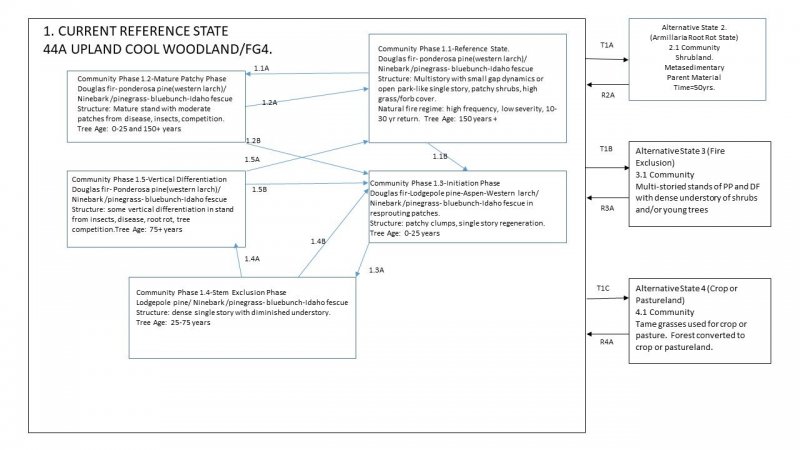
Natural Resources
Conservation Service
Ecological site F044AP903MT
Upland Cool Woodland Group
Last updated: 9/07/2023
Accessed: 12/18/2025
General information
Provisional. A provisional ecological site description has undergone quality control and quality assurance review. It contains a working state and transition model and enough information to identify the ecological site.
MLRA notes
Major Land Resource Area (MLRA): 044A–Northern Rocky Mountain Valleys
Major Land Resource Area (MLRA): 044A–Northern Rocky Mountain Valleys
This MLRA includes the northern portion of the Northern Rocky Mountain Valleys Province of the Rocky Mountain System. The mountain valleys are deeply dissected and are typically bordered by mountains trending north to south. The nearly level broad flood plains are bordered by gently to strongly sloping terraces and alluvial fans. The surrounding mountains and in some areas the valleys experienced glaciation. The average precipitation is 12 to 16 inches generally, though can vary widely. The dominant soil orders are Inceptisols, Mollisols and Andisols. The valleys support coniferous forests, shrublands and grasslands.
Description of MLRAs can be found in: United States Department of Agriculture, Natural Resources Conservation Service. 2006. Land Resource Regions and Major Land Resource Areas of the United States, the Caribbean, and the Pacific Basin. U.S. Department of Agriculture Handbook 296.
Available electronically at: http://www.nrcs.usda.gov/wps/portal/nrcs/detail/soils/ref/?cid=nrcs142p2_053624#handbook
Classification relationships
ASSOCIATED HABITAT TYPES:
PSME/PHMA5-CARU
ABGR/LIBO3
Ecological site concept
• Site does not receive any additional water
• Dominant Cover: Coniferous Forest
The reference vegetation community is closed canopy overstory of either Douglas fir with an understory of the medium statured shrub ninebark or Grand fir with an understory of the low statured twinflower. There is a diversity of other shrub and herbaceous species that can be present. Understory production averages 600 dry pounds per acre. The ecological dynamics are similar if the overstory is of Grand fir.
• Soils are
o Generally not limy (limited extent)
o Moderately deep, deep or very deep
o Not ashy or medial textural family
o Typically less than 5% stone and boulder cover (<15% max)
• Soil surface texture ranges from gravelly ashy silt loam or loam; ashy fine sandy loam to ashy loam in surface mineral 4”
• Parent material is thin mixed volcanic ash over alluvium, colluvium, glacial till, or glaciolacustrine deposits
• Drainage class is well drained; no flooding frequency
• Site Landform: stream terraces, lake terraces, hillslopes, mountain slopes, moraines
• Moisture Regime: ustic/xeric
• Temperature Regime: frigid
• Elevation Range: 2400-3400 ft
• Slope: 4-15%
Associated sites
| F044AP902MT |
Shallow Warm Woodland Group This associated ecological site resides on slightly drier site conditions than this ecological site. |
|---|
Similar sites
| F044AF004MT |
Montane Moderately Warm Dry Coniferous Pend Oreille-Kootenai Valleys Douglas fir/common snowberry The similar ecological site is limited to the LRU in the western most of portion of the MLRA. |
|---|
Table 1. Dominant plant species
| Tree |
(1) Pseudotsuga menziesii var. glauca |
|---|---|
| Shrub |
(1) Physocarpus malvaceus |
| Herbaceous |
(1) Calamagrostis rubescens |
Click on box and path labels to scroll to the respective text.

